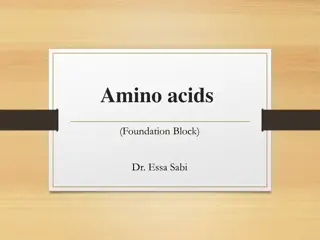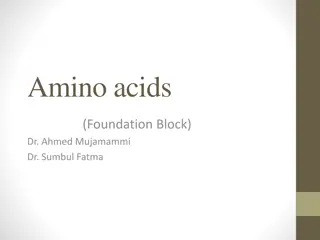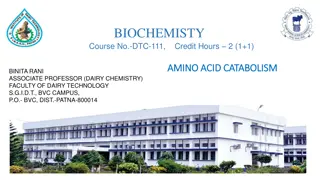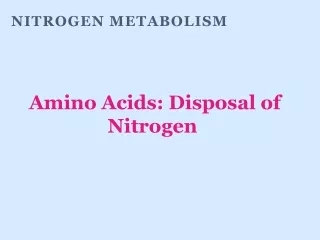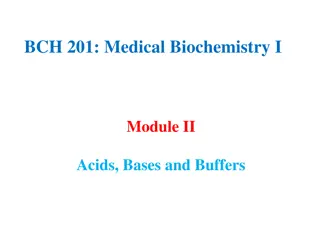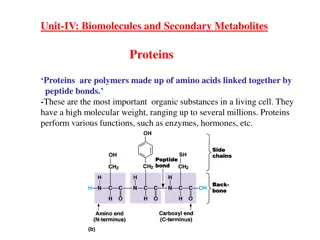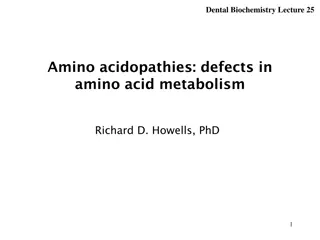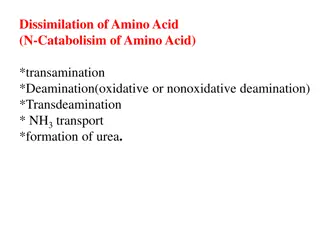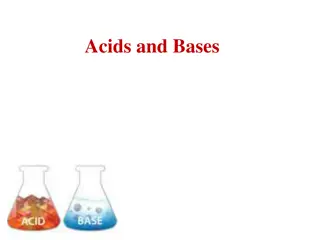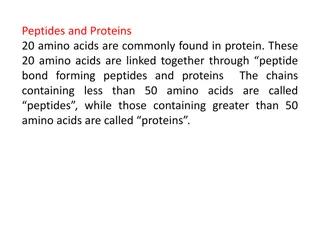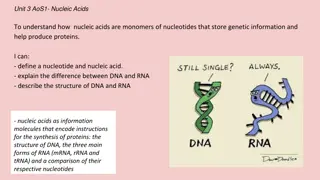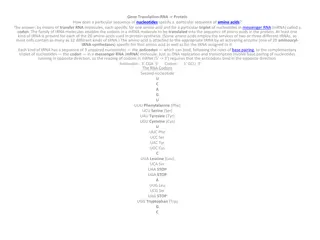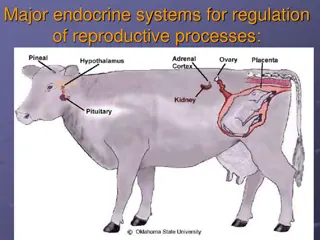Understanding Amino Acids: Structure, Types, and Importance
Amino acids are essential organic molecules that serve as the building blocks of proteins. They contain unique chemical groups and play crucial roles in various bodily functions. This article discusses the structure of amino acids, their different types (D and L), and highlights their importance in mood regulation, protein synthesis, arterial health, calcium absorption, and tissue repair. Additionally, it explores the classification of amino acids based on their chemical properties and essentiality in the diet.
Download Presentation

Please find below an Image/Link to download the presentation.
The content on the website is provided AS IS for your information and personal use only. It may not be sold, licensed, or shared on other websites without obtaining consent from the author. Download presentation by click this link. If you encounter any issues during the download, it is possible that the publisher has removed the file from their server.
E N D
Presentation Transcript
Al-Mustaqbal University College Anesthesia Techniques Department AMINO ACIDS LECTURE Article teachers M.sc. Zainab Mohsen F.I.C.M.S Path Dr. Ammar Hatem
Amino Acids Amino acids are any group of organic molecules that contain a basic amine group (NH2), a carboxylic acid group (COOH), and an organic group R that are unique to each amino acid and are the building blocks of proteins. And its shape is as follows: Amino acids differ from each other according to the specific chemical group, the R group
If the amine group is to the right of the carbon atom The amino acid is of type D. If the amine group is to the left of the carbon atom The amino acid is of the L type.
The importance of amino acids 1- Help improve general mood; That is, the mental and psychological state of the human body An example is the amino acid tryptophan, which is essential for the production of serotonin. 2- Protein building :When protein is broken down, the amino acids in the body build up the protein in the body again. 3- Amino acids, such as arginine, help the body maintain arteries elasticity.
4-Some amino acids, such as lysine, help the body better absorb calcium, which reduces weak and osteoporosis. 5- Repair of muscles, skin, and connective tissues: - they need amino acids to repair themselves when injured or damaged. Taking an amino acid like arginine after exercising can help your muscles recover.
CLASSIFICATION CLASSIFICATION Amino acids are classified mainly into three groups depending on their reaction in solution as neutral, acidic and basic amino acids which is known as chemical classification . They are also classified on the basis of their essentiality in the diet known as nutritional classification . Amino acids have also Metabolic Classification
Nutritional Nutritional Classification of Amino Acids Classification of Amino Acids Essential and Nonessential amino acids Nutritionally, amino acids are classified as essential and nonessential amino acids. Of the 20 amino acids, our body has the ability to synthesize 10 of them. Even if they are absent in our dietary proteins, our body can synthesize them. Hence, they are known as nonessential. On the other hand, our body cannot synthesize the remaining 10 amino acids, should be supplied through diet. Hence, they are called essential amino acids.
Metabolic Classification of Amino Acids Metabolic Classification of Amino Acids After the removal of amino group from amino acid, if the carbon skeleton of amino acid can be converted into glucose in the body, such amino acids are called glucogenic amino acids. Similarly, if the carbon skeleton of amino acid is converted into ketone body (acetoacetic acid), such amino acids are called ketogenic amino acids. Two amino acids leucine and lysine are exclusively ketogenic. If one part of the carbon skeleton is converted into glucose and other part is converted into ketone body, such amino acids are termed both glucogenic and ketogenic amino acid.
Peptide bonds Peptide bonds Individual amino acids can be linked by forming covalent bonds. The bond is formed between the a- carboxyl group of one amino acid and the a-amino group of the next one. Water is eliminated in the process, and the linked amino acid residues remain after water is eliminated. A bond formed in this way is called a peptide bond. Peptides are compounds formed by linking small numbers of amino acids, ranging from two to about 50 amino acids. In a protein, many amino acids are linked by peptide bonds to form a polypeptide chain of more than 50 amino acids .





